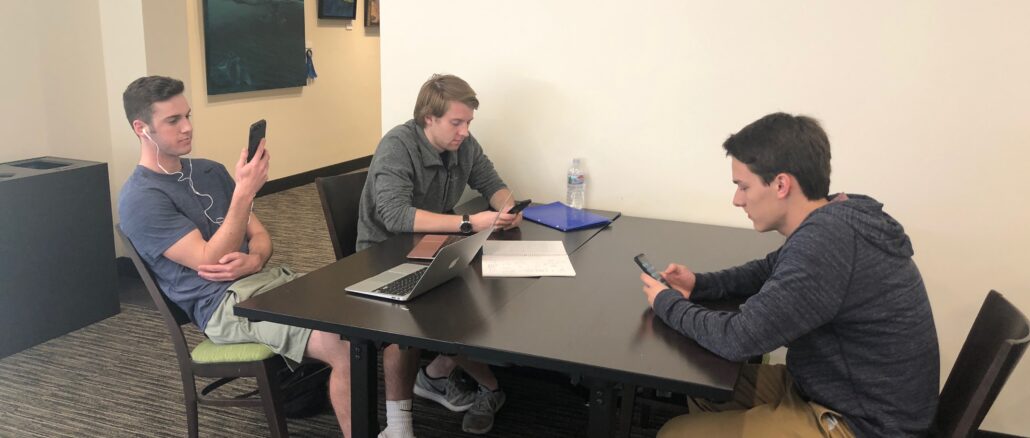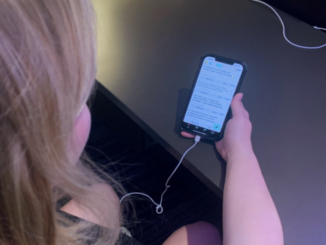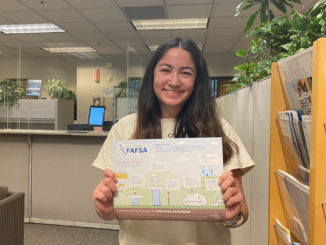
Pepperdine students who grew up with the world’s information at their fingertips lack news literacy and interest.
Students rely heavily on social media for what news they consume and do not have the news literacy skills they need to tell fact from fiction online, Pepperdine Journalism Professor Elizabeth Smith said. This leads students
to distrust the news media or ignore current events entirely, keeping them from developing unbiased, informed opinions.
“I think it gives people a false sense of being informed,” she said.
Students’ poor news intake habits impact their political involvement. Literacy skills are crucial to navigate a news cycle of endless information, Smith said.
Student’s news intake habits
A Pepp Post survey of 52 students found that about 60 percent said they regularly keep updated with the news.
Students said their favorite news sources were Fox News, CNN and The New York Times.
“My main source of news is The New York Times app on my cell phone,” said Nicholas “Jagger” Pirtle, a freshman international business major. “I read it practically every day.”
Students choose social media outlets, such as Twitter or Snapchat, over more credible sources of news such as The New York Times or CBS.
“Students should pay to subscribe to news sources, it’s cheaper than Netflix,” Smith said.
The Pepp Post survey found that students followed entertainment, political news and sports the most.
Entertainment and sports are both soft types of news, meaning students lack interest in hard-hitting news.
Nearly 40 percent of students said they pick their news source for convenience.
Students prefer the ease of digital and mobile news intake opposed to print. Reaching younger audiences is about keeping current with modern technology, said Emily Tencer, senior journalism major and Good Morning Malibu and NewsWaves reporter.
“I feel like we’re transitioning into a media stage everything is going to be about your phone,” she said. “We need to switch to a more digital mindset.”
How is social media changing the news?The survey found that nearly 42 percent of students said they primary receive their news through social media, around 21 percent said they read online versions of newspapers, and about 17 percent said they read news mobile apps. No one said they read print editions.
Social media is convenient, so it is clear why students are far more inclined to share on social media and the internet rather than talk in person or share what they read in print, Sebastián Valenzuela said in an Oct. 2017 “Journal of Communication” article.
Social media streams emphasize viral news stories that are highly emotional, Valenzuela wrote. These stories gain more interest and shares than more credible journalism.
“I try not to check it that often because it kinda sucks you in and I don’t like that,” freshman biology major Neek Hadjarpour said about his social media use.
Chris Soper, Pepperdine political science professor, finds social media to be a distraction for students, allowing them to chose only media that interests them.
”One thing social media allows is for people to be completely disengaged,” Soper said.
When students read only news their friends share on social media, they are often only getting a glimpse of what is happening in the world.
“People walk away thinking ‘I know what the headlines of the day are,’ ” Smith said. “But, that’s not true. You know what the headlines are of the people you’ve selected to follow, so you’re getting a very selected source of news that people have shared and re-shared,” she said.
Tencer herself relies mostly on social media for her news, though with stronger skills to discern what she’s reading.
“It’s just so fast so easy,” Tencer said.
Students are seeking digital over print forms of media to receive their news, Gabrielle Veselik, junior sports medicine major, said. She has never picked up the physical Pepperdine student newspaper, which is distributed all over campus.
“I have never picked up the Graphic and read it actually,” she said. “This isn’t the olden days. Why would I carry around an extra paper if it’s already just on my phone.”

Pepperdine newsstand locations:
The survey found that students were split on whether they feel well informed about current events happening in the world today: 52 percent said no to 48 percent yes.
Only 37 percent of students said they are required to keep up on current events for class.
What is news literacy?
“News literacy is the acquisition of 21st-century, critical-thinking skills for analyzing and judging the reliability of news and information, differentiating among facts, opinions and assertions in the media we consume, create and distribute,” according to the Radio Television Digital News Association Foundation.
Smith said she believes news literacy is the most important skill students should be learning, and that it should be taught as early as kindergarten.
“Because information is coming at us in so many different ways from so many different sources than even 10 years ago, it is really important that we are all learning news, information media literacy skills in a way we didn’t need them before,” she said.
There is a lack of trust in the news with “fake news” being a trending topic in the media. Audiences hearing “fake news” leads them to broadly apply it to all journalism. Audiences misunderstand differing opinions or bias to be “fake” even though it might be an opinion, not necessarily false or inaccurate. “Ratings are up and subscriptions are up but there’s less trust in the news and that is concerning,” Smith said.
A Gallop and Knight foundation study found that people’s political opinions and level of trust of the news influenced whether they saw bias in news articles,
Jonathan Rothwell wrote in a Sept. 26 New York Times article.
News intake impacting politics
Students’ news interest and participation influences the voting process and the structure of government, thus, impacting daily life. Soper expects his students to read the news to inform their political views. Reading a variety of news sources with differing political views is best to give readers a well-rounded perspective, Soper said. This allows people to understand other opinions and avoid settling into politically polarized bubbles.
“Students exposure to political news on average is limited to what they are getting on their Facebook feed probably or things that are sent to them,” Soper said.
Credible sources of news are vital to raising political awareness and deciding how to vote. Young voters engagement in elections is almost always lower than older voters, Soper said.
Students do not see the connection between what they read in the news and the affect it could take on their lives
“Younger people may feel that the issues are not as relevant to the things that they care about,” Soper said. “They don’t see a connection between what government is doing at the state, local level or federal level and what matters most to them.”
Why aren’t students engaging in the news?
The Pepp Post survey found that the main reason students do not read the news is because they do not have enough time. More than a third said sheer busyness kept them away, though other students reported tuning out the news because it was depressing, overwhelming or full of conflict.
“I hardly have enough time to sleep let alone read the news right now,” Becca Priede, junior international politics major, said.
Students said they do not have enough time to read the news even though they engage in social media. The audiences for every major sector of U.S. news media fell in 2017, Michael Barthel wrote in an Aug. 21 article for the Pew Research Center.
The Pepp Post survey found that nearly 60 percent said they have ignored the news on purpose.
“I’ve avoided the news before when I don’t want to know about everything going on in the world,” Larissa Seibt, junior integrated marketing communications major, said.
She is not alone in ignoring the news, either.
“Yes I avoided the news on purpose because it was either sad news, violent news, skewed news, or just news I wasn’t interested in,” Priede said.
Negative stories having conflict or tragedy are the most popular in news feeds, gaining the most attention.
“Honestly, I hate the news it’s so depressing, but I need to stay up on current events for class and be a well-informed American to know what is actually going on globally and nationally, ” Hayden Phillips, junior international studies major, said.
Students may also not be engaging because they’ve lost trust in the motives that drive the news industries. They doubt the legitimacy of the news and question if news sources are just trying to gain traffic.
“Bias in the news is inevitable at this point,” Simon Pilato, junior business administration major, said. “All news stations and reporters report the news that gets the most ratings, not what is most important. They’re fighting to stay alive and it ruins the relationship of trust people have with the news.”
Tencer had the idea of making news relevant by adding news to streaming services such as Netflix and Hulu. They are mediums college students usually access and would be more likely to engage, she said.
“I think the biggest way to keep news relevant with students is really focusing on impact,:Tencer said. “And also giving them that media through a medium that they are familiar with that’s their phones that is digitally and not so much sitting in front of the TV and reporting about it.”
Sarah Seltsam completed the reporting for this story under the supervision of Dr. Christina Littlefield and Dr. Theresa de los Santos in Jour 241 in fall 2018. Dr. Littlefield supervised the web story.




